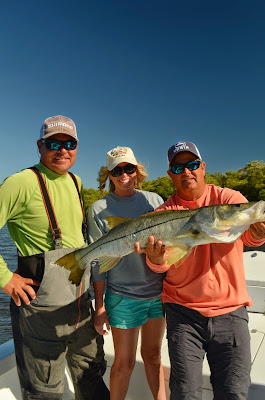Your site for all things outdoors. Here you will find stories of the outdoors from sharing a campfire with a kid in the backyard to chasing tarpon and turkey in the Yucatan.
Saturday, June 28, 2014
Ft. Myers Snook
Fort Myers Snook Fishing Rebounds
Snook are one of the premier game fish of southwest Florida. Unfortunately, a “cold kill” occurred in 2010, wiping out tens of thousands of fish in several age classes. Snook cannot survive water temperatures under 60 degrees. An especially cold winter decimated the stocks. However, snook populations rebounded quickly and the season re-opened in September of 2013.
Snook have long been on my bucket list. The long, slender fish are phenomenal fighters, which many call a souped-up largemouth bass. Personally, I think they leave a largemouth in the dust.
The sporty snook begin their annual move from the backwaters in March each year to the salty bays and inlets surrounding Ft. Myers. The full moon of May is the traditional kick-off for snook fishing, but I couldn’t wait. I was going in the middle of March, before the fishing crowds arrived.
Because of the mile after mile of gorgeous, white sand beaches surrounding Ft. Myers, it is a prime tourist destination, even in March. And, I just happened to land there during spring break. The crowds of sun seekers grew by the day. However, most peole were there to party rather than fish, so I didn’t feel the pressure.
I contacted Lee Rose, the Communications Manager of the Lee County Visitor and Convention Bureau. He hooked me up with Port Sanibel Marina and Capt. Ryan Kane. Strategically located just before the causeway leading to Sanibel Island, they were only minutes from where I stayed.
Capt. Kane quickly explained that snook are primarily ambush feeders. “They like to hide just inside the mangrove tangles and lie in wait for prey,” he said. “It can be real tough getting baits where they need to be. “Skipping” baits up under the over-hanging limbs is key to catching big snook.”
Most anglers use live bait for snook. “Live bait is the easiest way to catch snook,” Kane instructed. “I use live baits with most of my clients. Mullet, pinfish, croakers, or white baits, and live shrimp are common and fairly easy to acquire.”
Kane’s long time experience with snook had taught him well. He constructed his own lightweight boat so he could negotiate shallow waters which lead to snook hides. His medium-heavy rods were matched with Shimano reels spooled with 30-to-50-pound braid. Leaders consisted of 30-to-50-pound Fluorcarbon.
“It is best to match hook size to the bait you use,” Kane noted. “I use 1/0 to 2/0 circle hooks for greenbacks and shrimp. I go to 6/0 or 7/0 hooks for the bigger baits like pinfish and mullet.”
Less than two miles from from Port Sanibel Marina Capt. Kane eased his boat into a small bay out of the stiff wind. He climbed onto the front deck of the boat and began scouting the shadows at the edge of the mangroves. “I hunt snook,” Kane said. “Sight fishing for them is as fun as it gets. I love to spot a big snook and then fool it into biting.”
Minutes into his search, Kane spotted the first snook cruising in the shadows of the mangroves. “See him, Bill?” Kane asked.
A long dark shadow moved, effortlessly, to the left. I felt my blood pressure increase. The excitement had begun.
Kaitlin Rae, one of the manager’s of the marina, stepped to the bow. The bait skipped several times before settling up under the mangroves, a perfect cast. The snook turned to investigate. “Aaawwws” echoed from the boat as the big snook returned to the tangles.
Gulls and pelicans proved to be a real problem for us while we were trying to fish. The cunning birds began to check us out when they saw the boat come to a halt. They flew around near the boat until they saw one of us make a cast. Immediately, they plunged into the shallow water and grabbed our baits. Capt. Kane would grab the rod and skillfully jerk the bait alway from the avian thieves without hooking them.
Kane had considerable experience with thieving birds and had the perfect plan to distract them. He had a 30-inch long fluted tube, which he used to sling shrimp far away from the boat in the opposite direction from where we wanted to cast. it worked like a charm and allowed us enough time to cast our baits to the mangroves without being noticed by the marauding birds.
Minutes later Kaitlin connected when a second snook took her bait. “They are definitely here,” Kane whispered. “Lift and reel down. You’ve got a big one, Kaitlin.”
Kaitlin handled the big snook like a pro. The powerful fish made several runs before succumbing to her skills. Everyone aboard offered kudos for a job well done.
Dozens of photos later, Capt. Kane rigged another bait and the hunt was on again. We spotted dozens of big snook as we slowly moved down the line of mangroves. Numerous fish darted out of the dense over to investigate the squirming baits. However, they didn’t seem intent on eating the baits.
“The snook season is just beginning.” Captain Kane explained. “In the coming days and weeks, the bit will only get better.”
To check out the snook fishing opportunities at Ft. Myers, Florida check in with Lee Rose, Communications manger, Lee County Visitor and Convention Bureau at: www.FortMyersSanibel.com. You can contact Capt. Ryan Kane, of Southern Instinct Charters at: SOUTHERNINSTINCT@EARTHLINK.NET and Port Sanibel Marina at: Ryan.Clark@PortSanibelMarina.com.
Subscribe to:
Post Comments (Atom)





No comments:
Post a Comment